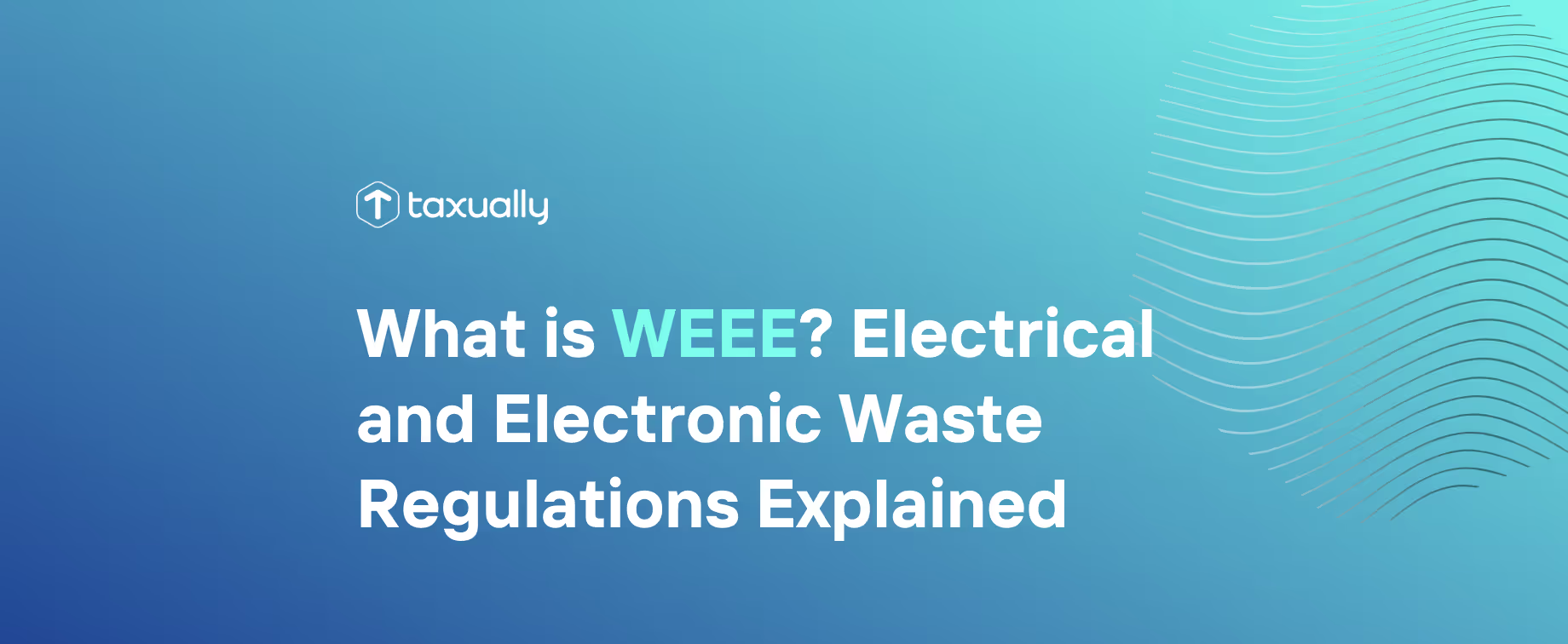Key takeaways
- WEEE encompasses a broad range of end-of-life electrical and electronic equipment, with significant environmental implications of improper disposal, including serious health risks and resource wastage.
- The WEEE Directive in the EU aims to address the environmental impacts of e-waste through prevention, improved resource efficiency, and mandated recycling, recovery, and reuse.
- Compliance with WEEE regulations extends to manufacturers, distributors, and sellers of electrical and electronic equipment and includes requirements such as registration, information provision, record-keeping, and joining Producer Compliance Schemes.
With technological advancements occurring at a breakneck speed, yesterday's cutting-edge devices quickly become tomorrow’s waste. This growing mountain of electrical and electronic waste, from smartphones to fridges, has necessitated the creation of specific regulations to manage its disposal safely and responsibly. Enter WEEE - Waste from Electrical and Electronic Equipment. But what is WEEE, what are the regulations surrounding it, and how can businesses ensure compliance and contribute to a more sustainable future?
Understanding WEEE: Waste Electrical and Electronic Equipment
Old electronics don’t just disappear when they reach their end-of-life. They transform into what is known as Waste Electrical and Electronic Equipment or WEEE. This includes everything from your mobile phones to large household appliances, and even electronic tools.
Serious environmental and health issues can stem from the improper disposal of WEEE. Metals and nanoparticles can contaminate water bodies, and heavy metals can seep into the ground, posing significant environmental and human health risks. Recycling WEEE enables the recovery of valuable raw materials like aluminum, iron, and copper, which not only prevents resource depletion but also reduces emissions.
As technology continually advances, electronic items become obsolete faster, contributing to an anticipated increase in global e-waste to 74.7 million metric tons by 2030. Alarmingly, the most recent figures put the e-waste recycling rate at just 17.4%. These statistics underline the urgency of managing WEEE effectively.
The WEEE Directive: aims and objectives

The European Unions's WEEE Directive 2012/19/EU aims to address the environmental issues arising from the growing amount of discarded electronics in the EU, and sets forth a clear agenda:
- Prevent the creation of WEEE.
- Enhance efficient resource use.
- Improve environmental performance across the lifecycle of electrical and electronic equipment.
The Directive’s objectives focus on:
- The safe management of hazardous substances.
- The prevention of environmental contamination through the proper treatment of WEEE.
- Mandating reuse, recycling, and recovery of WEEE to reduce its disposal and improve environmental outcomes.
The Directive also sets forth collection and recovery/recycling targets that will grow more stringent over time, reflecting the rising ambitions for WEEE management. It also calls for Member States to improve the separate collection of WEEE from unsorted municipal waste. Indeed, regular evaluations of the WEEE Directive’s effectiveness are carried out to ensure it stays relevant amidst the challenges presented by rising consumption and digitalization.
Categories of WEEE: what's covered?
WEEE’s scope is extensive, encompassing a wide array of equipment. Electrical and Electronic Equipment (EEE) includes devices that rely on electric currents or electromagnetic fields to function, designed for use with specific voltage ratings. EEE also includes products that are powered by alternative sources such as batteries or solar panels, if their operation depends on electric currents or electromagnetic fields. Among these devices, electrical and electronic tools play a significant role in various applications.
WEEE categories cover various types of equipment such as large and small household appliances, IT and telecommunications equipment, and consumer and lighting equipment. This includes both household and non-household products. But it’s not just about the end products. While components and sub-assemblies used for assembling EEE are not classified as EEE, end-user products are. Non-electrical accessories necessary for the EEE’s operation must be accounted for in its weight.
Latest WEEE categories
The Waste Electrical and Electronic Equipment (WEEE) Directive, as revised in 2012 (Directive 2012/19/EU), categorizes electronic waste into several broad categories to streamline collection, recycling, and recovery processes. These categories are designed to cover the wide range of electrical and electronic equipment (EEE) that, at their end of life, become waste. Here is a list of the complete WEEE categories as outlined in the directive:
- Large household appliances: This includes big items such as refrigerators, washers, stoves, and air conditioners.
- Small household appliances: Includes vacuum cleaners, hairdryers, coffee machines, and other small kitchen and household devices.
- IT and telecommunications equipment: This category covers computers, printers, telephones, and mobile phones, among other information technology and telecommunications equipment.
- Consumer equipment and photovoltaic panels: Encompasses TVs, radios, hi-fi systems, digital cameras, musical instruments, and photovoltaic panels.
- Lighting equipment: Includes lamps, light bulbs, and fixtures for households and professional use, excluding household luminaires and filament bulbs.
- Electrical and electronic tools: This broad category covers drills, saws, sewing machines, lawnmowers, and other hand-held, desktop, or freestanding tools.
- Toys, leisure, and sports equipment: Items such as electric trains, games consoles, running machines, and sports equipment with electronic components fall under this category.
- Medical devices: This includes devices like radiology equipment, analyzers, dialysis machines, and other electrical medical equipment, excluding implanted and infected products.
- Monitoring and control instruments: Covers smoke detectors, thermostats, weighing scales, and other monitoring devices.
- Automatic dispensers: This category is for machines that dispense hot drinks, bottles, snacks, money, and similar automated services.
- Display screens, monitors, and equipment containing screens having a surface greater than 100 cm²: Includes televisions, monitors, laptops, tablets, and other devices with significant display screens.
- Cooling appliances containing refrigerants: Specifically targets refrigerators, air conditioners, dehumidifiers, and other cooling appliances that contain refrigerants.
These categories are comprehensive and designed to encompass the vast majority of electronic products that might become waste. The aim of categorizing WEEE is to facilitate the specific handling and recycling processes needed for different types of electronic waste, each of which may contain a variety of materials that require specialized treatment to minimize environmental impact and recover valuable resources.
Compliance and best practices
For businesses, compliance with WEEE regulations means taking responsibility for the entire lifecycle of their products. This involves:
- Registration and reporting: Companies producing or selling electrical and electronic equipment must register with national environmental agencies and report the amount of goods put on the market and the quantity of waste collected and recycled.
- Take-back schemes: Implementing take-back schemes or partnering with recycling firms to ensure that end-of-life products are collected and processed in accordance with the regulations.
- Eco-design: Integrating environmental considerations into product design to improve repairability, durability, and recyclability.
WEEE country-specific requirements
The Waste Electrical and Electronic Equipment (WEEE) Directive, while harmonized across the European Union, allows member states some degree of flexibility in how they implement its requirements. As a result, specific obligations for producers and distributors can vary significantly from one country to another. Below is an overview of the country-specific requirements for France, Germany, and Spain.
France
- Eco-organization membership: Producers must join an eco-organization approved by the French authorities to handle the collection and recycling of WEEE. Eco-organizations, such as Eco-systèmes and ERP France, operate on a nonprofit basis and are financed by eco-contributions paid by producers.
- Registration and reporting: Producers must register with the French Environment and Energy Management Agency (ADEME) and regularly report the quantities of EEE placed on the market, collected, and recycled.
- Take-back scheme: Retailers must take back, on a one-for-one basis, old equipment from customers buying new EEE. There's also an obligation for distributors of electrical and electronic equipment to inform consumers about their right to return WEEE.
Germany
- EAR registration: Producers must register with the Foundation Elektro-Altgeräte Register (EAR), the national register for WEEE in Germany, before placing any EEE on the market. EAR assigns each producer a WEEE registration number, which must be indicated on invoices.
- Compliance scheme participation: While producers can organize their own take-back and recycling systems, most join a compliance scheme (take-back system) that takes over operational and financial responsibilities for WEEE.
- Clearing house system: The EAR acts as a clearing house, allocating collection and recycling responsibilities among producers based on their market share and the type of equipment they produce.
Spain
- Integrated Management Systems (IMS): Producers in Spain must join an Integrated Management System (IMS), similar to eco-organizations in France, authorized by the regional governments. The IMS takes care of the collection, treatment, and recycling of WEEE.
- Registration and reporting: Producers must register with the Registry of Industrial Establishments in the Autonomous Community where they first place products on the market and report the quantities of EEE placed on the market and managed as WEEE.
- Take-back obligations: Producers and distributors are required to provide customers with the option to return old devices free of charge when purchasing new ones, ensuring the devices are of a similar type and function.
Potential penalties for non-compliance

Non-compliance with Waste Electrical and Electronic Equipment (WEEE) regulations in the European Union can result in significant penalties, which vary depending on the specific member state's legislation implementing the EU Directive. Penalties can include:
- Fines: These are the most common form of penalty for non-compliance with WEEE regulations. The amount can vary widely from one member state to another and can be significant, often calculated based on the severity of the non-compliance, the environmental impact, and sometimes the company's turnover.
- Suspension or revocation of business licenses: In serious cases of non-compliance, authorities may suspend or even revoke the operating licenses of the businesses involved. This can prevent the company from carrying out any business activity related to electronic and electrical equipment until compliance is achieved.
- Criminal charges: For particularly egregious violations, especially those that result in significant environmental harm or risk to human health, criminal charges may be brought against the company or its responsible officers. This could lead to trials and, if convicted, imprisonment.
- Compulsory take-back or recall orders: Companies may be ordered to take back non-compliant products at their own expense. This can also include the cost of recycling or properly disposing of the products, which can be substantial.
- Restrictions on market access: Non-compliant companies might find their products barred from being sold in the EU market, which can be a significant financial blow given the size of the market.
- Cost recovery: Authorities may recover the costs of enforcement actions, including cleanup, monitoring, and administration costs, from the non-compliant entity.
The specific penalties are determined by each EU member state, so it's crucial for businesses operating in or exporting to the EU to be familiar with the national laws of each country they operate in.
Conclusion
WEEE represents a significant compliance challenge for businesses but also an opportunity to drive towards a more sustainable and circular economy. By understanding and adhering to WEEE regulations, businesses can not only comply with legal requirements but also contribute to the conservation of valuable resources and the reduction of environmental pollution.
If you're confused by WEEE and the wider EPR (Extended Producer Responsibility) regulations now mandatory for businesses operating in France, Germany, and Spain, we can help. Our specialist EcoTax team has the expertise needed to guide your company through every step of the WEEE and EPR process. Book a free call with one of our experts today.
Frequently asked questions
New Year's Day - 1/1/2024Memorial Day - 5/27/20244th of July - 7/4/2024Labor Day - 9/2/2024Thanksgiving Day - 11/28/2024Day after Thanksgiving - 11/29/2024Christmas Eve - 12/24/2024Christmas Day - 12/25/2024
What is the full meaning of WEEE?
WEEE stands for Waste Electrical and Electronic Equipment, which refers to regulations and directives aimed at reducing environmental impacts caused by end-of-life electronic and electrical items.
What is classified as WEEE waste?
WEEE waste includes large household appliances such as fridges, cookers, and microwaves, small household appliances like vacuum cleaners and toasters, and IT and telecommunications equipment such as personal computers and telephones.
Who is affected by WEEE regulations?
Manufacturers, importers, and distributors of electrical and electronic equipment (EEE), as well as consumers and recycling firms, are affected.
How can businesses comply with WEEE regulations?
Businesses can comply by registering with national WEEE registries, marking their products with the appropriate WEEE labeling, and ensuring proper disposal and reporting of electronic waste.



















